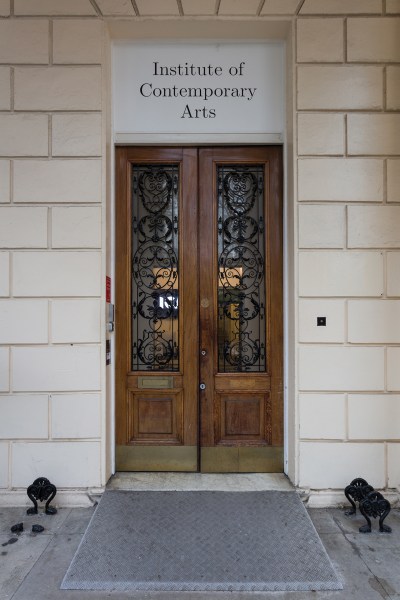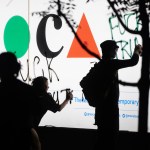IN THE TOWER OF FRANKFURT’S Museum für Moderne Kunst (MMK), where Cameron Rowland’s newest exhibition, “Amt 45 i,”is currently on display, there is an enormous cast-iron sugar kettle, five feet in diameter. In an essay accompanying the exhibition, Rowland writes that such kettles “operated through systematic torture,” the persistence of which “kept the sugar mill in near-constant production,” more than 16 hours a day. Quoting C.L.R. James’s landmark Black Jacobins: Toussaint l’Ouverture and the San Domingo Revolution (1938), Rowland writes that the unceasing whip served as “the incentive to work and the guardian of discipline” for the enslaved Black people forced to sustain colonial sugar production. Today, kettles like the one in Frankfurt circulate in antiques sales, and are a popular staple in lawn decoration in the American South, used as firepits or basins for water fountains. Rowland acquired their kettle from a dealer who purchases them from former plantations and retrofits them
for contemporary use.

Cameron Rowland: Ingenio, 2023. 19th-century sugar kettle, made in England, used in Louisiana. 72 ⅞ × 72 ⅞ × 26 ¾ inches (185.10 × 185.10 × 67.95 cm).
In Spanish the colonial sugar mill was called the ingenio, which meant “the engine.” The mill was a necessary component of the sugar plantation. Harvested cane had to be milled quickly to keep it from rotting. The mill operated 16–18 hours a day. Enslaved black people grew the cane, harvested the cane, crushed the cane, and boiled the juice. The mill consisted of a series of open kettles that were made in Europe, exported to the colonies, and used by slaves to reduce cane juice into syrup and raw crystals. The ingenio operated through systematic torture.
The regularity of punishment kept the sugar mill in near-constant production. “The slaves received the whip with more certainty and regularity than they received their food. It was the incentive to work and the guardian of discipline.” Sugar was made this way for 400 years.
C. L. R. James, The Black Jacobins: Toussaint l’Ouverture and the San Domingo Revolution, 2nd rev. ed. (New York: Vintage Books, 1989), 12.
Courtesy the artist and Maxwell Graham Gallery, New York
Much can be lost in the oversimplification of brevity, but Rowland’s agile artistic experiments with reparations can be summarized in one sentence from Saidiya Hartman’s 1997 book, Scenes of Subjection: “Emancipation instituted indebtedness.” Or, as Rowland puts it in one of the lengthy, rigorously researched pamphlets that accompany their artworks, “abolition preserved the property established by slavery … this property is maintained in the market and the state.” Further, as with the sugar kettle, Rowland’s approach to reparations involves interventions that illuminate how our entire economic system, from financial institutions to supply chains and markets—including antiques—continues to profit from the institution of Black chattel slavery; their artistic treatments of reparations imagine revolutionary market subversions, and model ways to undermine capitalism’s very notion of value, which is buttressed by the fetishization, commodification, and literal sale of Black life.
Despite Rowland’s prolific writing about their orchestrated interventions or the horrifying histories of slavery’s violence indexed by historical and contemporary quotidian objects, when it comes to Cameron Rowland the person, the artist keeps the details of their life deliberately opaque. They refuse to publicly share biographical information—just their year and city of birth, and their alma mater: 1988, Philadelphia, Wesleyan University. There are few photographs of them online, and they were clear that I was not to quote our recorded conversation directly when I visited their Queens studio: everything that could and should be quoted about their work, they said, can be found in the pamphlets.
This is not because they are in any way unfriendly, standoffish, or even performing a persona of mystery. Rowland is chatty, vulnerable, and exceptionally knowledgeable—a dream conversationalist. But they stressed that their aversion to biography is a result of the art world’s tendency to cast works by Black artists as necessarily and reductively a product of their background and biography. This veritable ghettoization leads non-Black audiences to look to Black art to learn about lived experiences that are unlike their own—Black work is too often presumed to be primarily an aesthetic translation of the course of the artist’s life rather than, for instance, an illustration of their conceptual and political interests. In this way, Black art is framed as representational or somehow autobiographical even when it is not. Anonymity allows Rowland’s primary concern—reparations—to take center stage.
AT FIRST GLANCE, ROWLAND’S 2016 breakthrough exhibition at Artists Space in New York simply comprises readymade pieces, like a desk and a pair of work uniforms. But the show was titled “91020000”after the Artists Space’s customer account number with Corcraft, also known as the Division of Correctional Industries. Rowland purchased objects—such as oak courtroom benches, manhole leveler rings, and an office desk—from Corcraft, which operates inside the New York State Department of Corrections and Community Supervision, and conscripts incarcerated people to perform manufacturing labor. Corcraft claims on its website that their intention is to cultivate “skill development, work ethic, respect and responsibility” that inmates can use upon release. But the compensation those inmates receive is so staggeringly low—often less than $1 per hour—that critics, including Rowland, have referred to and historicized it as modern-day slavery. In fact, the 13th Amendment’s abolition of slavery makes a notable exception for carceral punishment, clarifying that abolition is upheld “except as a punishment for crime whereof the party shall have been duly convicted.” The amendment ushered in an era of post-Emancipation labor practices that included chain gangs and convict leasing—the provision of prison labor to private companies.
“91020000” coupled symbolic and material intervention: an integral part of the show was the creation of a trust, the Reparations Purpose Trust, for a 2016 piece called Disgorgement. The Reparations Purpose Trust purchased 90 shares of the Aetna insurance company, and will hold them until the United States Government pays financial reparations, either per the recommendations cited in research pertaining to Congressional Bill H.R. 40, which would create a commission to study reparation proposals, or some other arrangement.
Rowland took aim specifically at Aetna because, as they detail in their essay for the exhibition, the insurance company was one of many that sold insurance to slaveowners and continues to profit from interest accumulating on those policies today. Slave insurance became an especially crucial part of the labor market after the 1803 prohibition on importing new slaves. By then, the labor market had become so dependent on slave labor that slaveowners began leasing their slaves to business owners, and also sought insurance against loss, should their property die or be injured. Rowland found that “the profits incurred by these policies are still intact within Aetna.” Their essay goes on to describe how, in 2002, lawyer Deadria Farmer-Paellmann filed the first ever corporate reparations lawsuit seeking disgorgement—the repayment of dishonestly or unethically acquired funds—from 17 different slavery-profiteering financial institutions, including Aetna. She argued unsuccessfully that the companies should allocate these profits to the descendants of enslaved people such as herself.
Presented in the exhibition as a series of framed legal contracts on bright white paper, Rowland’s trust materializes as both art object and evidence of legal and financial transactions that preserve profits from the institution of slavery. And their treatment of carefully purchased objects is a thoughtful interpretation of Marcel Duchamp’s readymade: the reorientation of a quotidian item into a sculptural, historical index of anti-Blackness. Operating simultaneously in the registers of the material and the symbolic, Rowland’s reparative gesture intervenes in the continued generation of profits from slavery.
Disgorgement, notably, engages both financial and affective value—reparations must exist in multiple registers beyond mathematical calculations of compensatory obligation. Rowland noted to me that trusts are a primary means of transferring intergenerational wealth, and a purpose trust, specifically, is a noncharitable trust the wealthy often use to stow money away in offshore accounts. Through this trust, we can more easily see the longue durée of profiteering in the ongoing afterlife of slavery: the trust’s exponential growth since 2016 mirrors and exposes corporations’ ability to continue deriving profits from an institution nearly 160 years after its purported abolition. That the government has yet to act on reparations lends an incompleteness to Rowland’s gesture: the trust, with Rowland as the enforcer, becomes a material representation of the United States’ anti-Black political imaginary. Its continued existence is predicated on a restitution for slavery deferred and foreclosed.
ROWLAND’S NEXT MAJOR intervention, Depreciation (2018), sought to strip a land asset of its value to prevent further profiteering. The piece engages General William T. Sherman’s 1865 promise of “forty acres and a mule” to former slaves that has since become a prototype with which subsequent reparations efforts have to contend. While many Americans believe the promise was never fulfilled, Rowland told me that, in a sense, the first part did come to fruition. Sherman’s wartime Special Field Order No. 15 issued instructions to settle former slaves displaced by the Union campaign on the Sea Islands, a chain of islands off the coast of South Carolina and Georgia. There, tens of thousands of newly freed Black people were resettled on some 435,000 acres. But, the artist clarified, the Order did not specify whether this exchange of land was meant to be permanent. It was exchanged on the basis of a possessory title, which involves the transfer of property in an instance where the owner is unable to provide documentary evidence of true ownership; therefore, such titles could be rescinded. Indeed, after Abraham Lincoln’s assassination, President Andrew Johnson promptly revoked the Order, returning the land to its previous planter owners.
It was on one of these Sea Islands that Rowland’s next legal venture proceeded. In 1866, the previous owners of Maxcy Place, a plantation on Edisto Island, repossessed it, and while there were freed Black people living and working there, neither those Black people’s names nor the contractual conditions of their labor have been found. Rowland made a market rate purchase of a single acre of land, and, through the nonprofit 8060 Maxie Road, Inc., imposed a restrictive covenant that legally prevents development and use of the land; this effectively deprives the land of the value derived from forced labor by excising it from the antagonistic real estate market enforcing this anti-Black property relation. In so doing, they stripped the land of its monetary value: it was officially appraised at $0 after being rendered legally unusable. This financial condition persists as long as does the nonprofit’s restrictions; as does Rowland’s purpose trust, the covenant endures indefinitely.
Depreciation is on extended loan to the Dia Art Foundation, which will steward the inaccessible land as it does other iconic works of Land art, from Robert Smithson’s Spiral Jetty to Walter De Maria’s Lightning Field. Dia does not own the piece, as Rowland refuses to allow it to become the property of an institution. Currently, documents related to the covenant are on display at Dia’s exhibition space in New York. Meanwhile, Disgorgement is on extended loan to the Museum of Modern Art in New York, and the museum has agreed to serve as grantor in the event Artists Space, a smaller nonprofit, is unable to continue.

Cameron Rowland: Encumbrance, 2020.
Mortgage; mahogany double doors: 12 Carlton House Terrace, ground floor, front entrance The property relation of the enslaved included and exceeded that of chattel and real estate. Plantation mortgages exemplify the ways in which the value of people who were enslaved, the land they were forced to labor on, and the houses they were forced to maintain were mutually constitutive. Richard Pares writes that “[mortgages] became commoner and commoner until, by 1800, almost every large plantation debt was a mortgage debt.” Slaves simultaneously functioned as collateral for the debts of their masters, while laboring intergenerationally under the debt of the master. The taxation of plantation products imported to Britain, as well as the taxation of interest paid to plantation lenders, provided revenue for Parliament and income for the monarch.
Mahogany became a valuable British import in the 18th century. It was used for a wide variety of architectural applications and furniture, characterizing Georgian and Regency styles. The timbers were felled and milled by slaves in Jamaica, Barbados, and Honduras among other British colonies. It is one of the few commodities of the triangular trade that continues to generate value for those who currently own it.
After taking the throne in 1820, George IV dismantled his residence, Carlton House, and the house of his parents, Buckingham House, combining elements from each to create Buckingham Palace. He built Carlton House Terrace between 1827 and 1832 on the former site of Carlton House as a series of elite rental properties to generate revenue for the Crown. All addresses at Carlton House Terrace are still owned by the Crown Estate, manager of land owned by the Crown since 1760.
12 Carlton House Terrace is leased to the Institute of Contemporary Arts. The building includes four mahogany doors and one mahogany handrail. These five mahogany elements were mortgaged by the Institute of Contemporary Arts to Encumbrance Inc. on January 16th, 2020 for £1000 each. These loans will not be repaid by the ICA. As security for these outstanding debts, Encumbrance Inc. will retain a security interest in these mahogany elements. This interest will constitute an encumbrance on the future transaction of 12 Carlton House Terrace. An encumbrance is a right or interest in real property that does not prohibit its exchange but diminishes its value. The encumbrance will remain on 12 Carlton House Terrace as long as the mahogany elements are part of the building. As reparation, this encumbrance seeks to limit the property’s continued accumulation of value for the Crown Estate. The Crown Estate provides 75% of its revenue to the Treasury and 25% directly to the monarch.
Courtesy the artist and Maxwell Graham Gallery, New York
OVER TIME, ROWLAND’S TARGETS have grown increasingly ambitious: in a show coinciding with the global upsurge of the ongoing Covid pandemic, they trained their attention on the British Crown. Where Depreciation engages undeveloped land, Rowland’s exhibition at the Institute of Contemporary Arts (ICA) London, considers the global market circulation of valuable products whose raw material was
a result of forced labor. The show’s title, “3 & 4 Will. IV c. 73,” references the official parliamentary citation of the 1833 Slavery Abolition Act, which both criminalized the purchase and ownership of slaves throughout much of the British Empire, and compensated slaveowners—not formerly enslaved people for their loss of property and inevitable profit. Rowland notes in their exhibition essay that the government’s “taxation of plantation products imported to Britain, as well as the taxation of interest paid to plantation lenders, provided revenue for Parliament and income for the monarch.”
The Crown Estate still owns 12 Carlton House Terrace, the address of the property leased to the ICA. Rowland’s show addresses the building’s history, and illustrates the institution’s continuing profit from slavery, pointing specifically to the mahogany doors and handrails added by King George IV in the 19th century. In our studio visit, they specifically described how few people realize that enslaved people in British colonies in the Caribbean and Central America cultivated much of the mahogany used in Regency architecture. They attributed this to the fact that so much scholarship about Caribbean slavery has been deliberately suppressed by British academia, including the watershed 1944 text Capitalism and Slavery by Trinidadian and Tobagonian historian Eric Williams. It was only in 1964 that the book found a publisher in the United Kingdom.
Drawing attention to the atmospheric omnipresence of slavery’s afterlife, Rowland also targeted the financial holdings of the British Crown with Encumbrance, an artwork that seeks to disrupt—as another form of reparations—the slavery-derived accumulated worth of one of the world’s wealthiest political entities. They laughed as they described this process to me, recalling the refusal of British legal practitioners to undermine or even challenge the royal estate. Rowland established a company called Encumbrance, Inc., to which the ICA mortgaged five mahogany elements for £1,000 apiece. While Rowland will not collect payments on the mortgage loan to Encumbrance, Inc., the company retains security interest—i.e., a legal right to debtor’s property as collateral in the event that they default—and this interest will, as Rowland writes, “constitute an encumbrance on the future transactions of 12 Carlton House Terrace.” The name Encumbrance refers to a mortgage on assets that does not prevent the property from being exchanged but depreciates its value. Their essay further explains that “plantation mortgages exemplify the ways in which the value of people who were enslaved, the land they were forced to labor on, and the houses they were forced to maintain were mutually constitutive.” Rowland’s pamphlet notes that mahogany “is one of the few commodities of the triangular trade that continues to generate value for those who currently own it.” Though Britain’s self-congratulatory myth positions it as the first imperial power to abolish slavery, the British Crown’s staggering wealth continues to grow as a result of their colonial holdings and participation in transatlantic slavery.
DESPITE A DEEP INTELLECTUAL commitment to the far-reaching financial dimensions of racial slavery, Rowland is delightfully irreverent. Their current show at Frankfurt’s Museum für Moderne Kunst (MMK) is among the most extraordinary ways in which they’ve conscripted an institution to participate in their experiments with reparations. They shared that bringing this slavery-centered political narrative to Germany, however, met with some difficulty because the recognition of colonial anti-Blackness these days can be perceived as displacing the centrality of the Holocaust, which currently exists within a zero-sum landscape of public memory.
Their show “Amt 45 i” materially implicates German institutions in the slave trade, just as their prior shows did British and American ones. In our conversation, they noted that in the 19th century, Germany attempted to circumvent the cotton monopoly held by British colonies in the Caribbean. In an effort to enter the international market as a cotton exporter, Germany began an agricultural campaign in its German East Africa colony (present-day Burundi, Rwanda, and Tanzania) to force natives to grow cotton. Local communities rebelled in 1905, then war broke out, and up to 300,000 people died from
a combination of drought-induced famine and a brutal German scorched-earth campaign. Slavery was never legally abolished in the colony.
The show’s primary intervention, titled Bankrott, German for “bankruptcy,” is an experiment in indefinite debt, designed to contrast with the colonial endeavor to extract and produce seemingly infinite wealth. In Frankfurt—financial center of both Germany and Europe—Rowland established Bankrott Inc., through which they issued a €20,000 loan (about US$22,000) to the MMK. It is a demand loan, one with no fixed duration or repayment schedule, and it can be recalled by the lender at any time. Rowland explained that, as an artist, they have no incentive to call the loan, since continuously accumulating debt is the foundation of the piece’s existence. The loan is currently accruing indefinite interest at 18 percent.
This ever-increasing debt, were it ever to be called, is owed to Bankrott Inc. by the city of Frankfurt itself, since MMK is a government department: the titular “Amt 45 i.” In 2043 the value of the loan will be an estimated €647,827.64; by 2063, it will have ballooned to €17,783,078.20; and by 2122, it will approximate the city’s entire operating budget, growing to €311,591,692,053.27. Unpayable Debt, as described by Brazilian scholar Denise Ferreira da Silva in her eponymous 2022 book, is “an obligation that one owns but is not one’s to pay.” Rowland writes that this intervention “does not seek to redistribute the wealth derived from slave life but seeks to burden its inheritors.” Though this particular unpayable debt is quantified and has a calculated projection, its astronomical value is analogous to the overwhelming grandness of the value of reparations owed.
Reparations and restitution have become buzzwords in art, and especially in museums, which are mired in debate about institutional ability and ethical responsibility to return stolen art objects to communities of origin. But Rowland’s reparative gestures refuse to be fixed in this framework. Rather than pretending that object restitution or even paying reparations can sufficiently right these deep moral and material wrongs, they confront the financial systems that continue to derive and reproduce profit, meaning, and value from racial slavery, plying that system’s very logic against itself.
This post was originally published on this site be sure to check out more of their content.






